TechRadar Verdict
Sony shows the world how to make a 'proper' mini phone
Pros
- +
Flagship specs
- +
Waterproof
- +
Decent battery life
Cons
- -
Poor bundled services
- -
Awful low light photography
- -
Glass back prone to smudges
Why you can trust TechRadar
A mini handset has, inexplicably, come to mean a smaller, lower-spec version of a popular big screen device, which does nothing for those that want a slightly smaller display.
With the release of the Xperia Z1 Compact in 2014 (having launched in Japan in 2013) we were pleased to see Sony bucking the trend by shrinking down the powerful Xperia Z1 but losing almost nothing on the spec list, giving the Z1 Compact a real chance to fight fight in a fierce market, that at the time was dominated by the HTC One Mini 2 and Samsung Galaxy S5 Mini, two devices that launched to critical acclaim but with a poorer spec list.
It's a trick that Sony has since repeated with the Xperia Z3 Compact, which again manages to pack a lot of the Xperia Z3's best features into a smaller body.
Eagle eyed readers will have noticed that the Sony Xperia Z1's baby brother hasn't adopted the traditional "Mini" moniker but rather comes with the title of "Compact".
Yes, Sony has given the Z1 Compact the smaller screen, but it has kicked diminutive RAM and lesser cores to the mobile kerb. Sony has even allowed the Xperia Z1 Compact to keep the waterproof nature of the Z1.
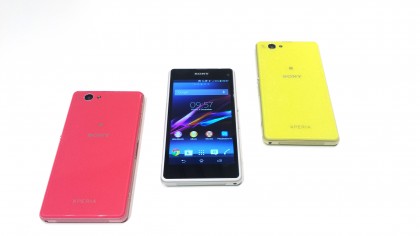
The Sony Xperia Z1 Compact can now be picked up from as little as £215 SIM-free ($317, around AU$413) and free on contracts starting at £18 per month.
Despite the recent price drops, this does mean that the Xperia Z1 Compact is still more expensive than the Samsung Galaxy S4 Mini and the HTC One Mini, which launched around 6 months earlier and have also seen their fair share of price drops since their newer versions (the Samsung Galaxy S5 and the HTC One Mini 2 respectively) came out.
Sign up for breaking news, reviews, opinion, top tech deals, and more.
This higher cost does allow much better specs though: it means the inclusion of a Qualcomm Snapdragon 800 2.2GHz quad-core CPU backed up by 2GB RAM for instance.
The Sony Xperia Z1 Compact's successor, the Xperia Z3 Compact, has also seen a few price drops of its own, and can be had for around £290 (around $428, AU$557). With a Snapdragon 801 2.5GHz CPU, the Xperia Z3 Compact has a slight edge over the Xperia Z1 Compact, but not enough that you should discount the cheaper handset, which offers fantastic value for money.
The "Compact" name also alludes to more than just the smaller size; it can be no coincidence that the Xperia Z1 Compact shares its name with the style of camera that it is looking to replace. A 20.7MP Exmor sensor housed behind an award-winning G Lens aims to be the final nail in the compact camera coffin.
Unsurprisingly, the Sony Xperia Z1 Compact follows in the same design language that was started with the Xperia Z1.
A full frontal glass assault is joined by an all glass rear that gives the Xperia Z1 Compact a really clean feel. The choice of four colours (black, white, pink and lime) means that the business feel can be offset a little if you wish.
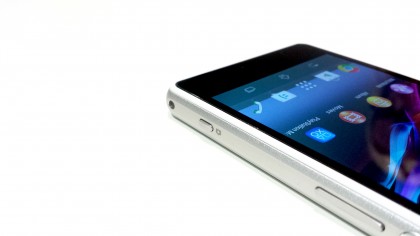
While the glass adds to the industrial feel, I found that it also meant I became a little obsessed with keeping it clean. Those that find they are forever trying to clean the screen to remove pesky fingerprints will find that that feeling transfers identically to the back.
It also hoovers up dust from the pocket, making it a real eyesore when you're just trying to look at a quick text.
The chassis, measuring at 127 x 64.9 x 9.55mm, curves slightly at the edges allowing the screen to be protected from side impacts, as well as allowing it to sit comfortably in the hand. I found that the metal and glass often left the Xperia Z1 Compact cold to touch when left out, but the material combination also leaves it feeling premium.
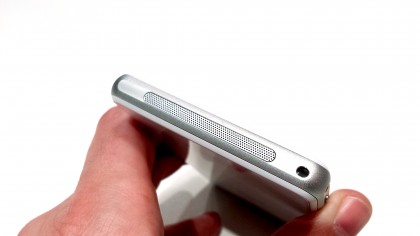
It's this combination of materials that leaves the Z1 Compact sitting on the scales at 137g, although I found that I still needed to check my pocket occasionally to see if it was still there. There is no doubt that the phone feels a little heavy at first, especially when compared to the almost impossibly light Galaxy S5 Mini, but this feeling disappears as quickly as it is noticed.
The smaller frame made using the Xperia Z1 Compact easy to use one handed, and didn't suffer the same problems of grip that beset the original Xperia Z1. The power key in particular was pretty easy to hit.

The curved edges also meant that I found it was more comfortable in one-handed use than the iPhone 5S, retaining the same business feel but without the sharp edges. However, the feel in the hand is one of a chunkier device - it doesn't have the same smooth stylings of the HTC One M8, for instance, and does feel quite hefty compared to other, better-balanced, phones.
Behind all that glass sits the first clue that the Xperia Z1 Compact isn't quite a fully-fledged flagship; a 720p 4.3-inch screen.
Many may scoff at the lower resolution, but Sony has given the screen a lot of attention, certainly more than was provided to the original Z1.
Pure stats show that the Xperia Z1 Compact has enough to compete, as its 340ppi outstrips that of the four-inch iPhone 5S, and even the newer iPhone 6. The Xperia Z3 Compact's larger 4.6-inch screen keeps the same 720p resolution, which means the newer handset has a slightly lower pixel density at 319ppi. Even so, the level of attention goes deeper than that as Sony looked to address issues that were found when the Xperia Z1 launched.
Gone are poor viewing angles thanks to the inclusion of IPS technology to join the Bravia and Triluminos tech that were found in Sony's largest handset, the Xperia Z Ultra.
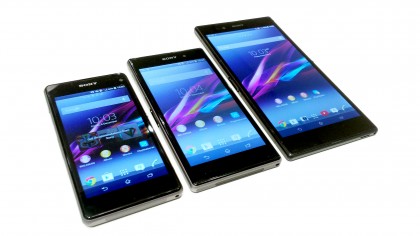
However, coming to this from looking at a 1080p screen and you will be able to see the drop in level of sharpness - it's not massive, but the Z1 Compact doesn't have the clearest screen on the market.
Making the Xperia Z1 Compact dust and waterproof (to IP55 and IP58 standards) can't have been easy with the number of ports that the modern smartphone requires. Thankfully, Sony has managed this well, leaving me impressed with the way they are securely covered.
All bar one of the ports comes with an attached bit of plastic that stands up to some rigorous pulling, with Sony having fully waterproofed the 3.5mm headphone jack. Even the external speaker that runs across the base of the Xperia Z1 Compact has been given the treatment.
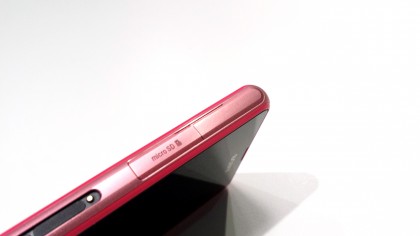
The microUSB port and microSD slot (the Sony Xperia Z1 Compact supports up to a further 64GB of storage) are housed at the top of the left side, with the microSIM tray sat at the base. I found that this tray was rather flimsy, as well as being difficult enough to require tweezers to remove. Popping in a microSD card was a lot simpler.
With all the ports in the left side, Sony has left the right-hand edge to be populated with a couple of buttons. Amongst these is the standard volume rocker sat just below Sony's round and imposing power/lock button, as well as a TechRadar favourite: a dedicated camera shutter button.
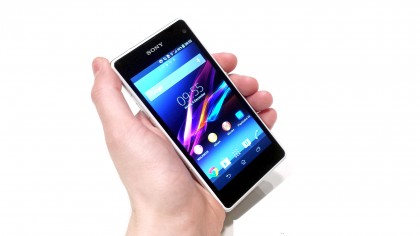
This serves a few purposes as it allows the Z1 Compact's 20.7MP camera to be loaded (and even have the photo shot right away) in one touch, as well as allowing photos to be taken underwater as the screen doesn't have to be pressed.
It also allows the camera app to function more like a fully fledged camera, with focussing and snapping being really easy.
The top and bottom edges contain only the waterproofed 3.5mm headphone jack and external speaker, respectively.
As with every smartphone, the back of the phone contains the camera sensor and LED flash. Elsewhere, only the Sony and NFC branding break up the solid glass rear.
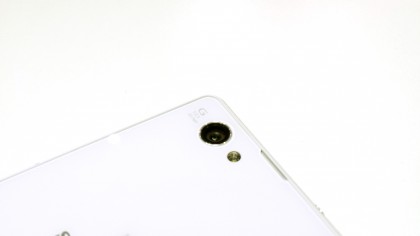
The Xperia Z1 Compact may come a higher price tag than its 'Mini' counterparts but also packs a smarter more professional feel backed up with whizzier insides that warrant a second and third look.
